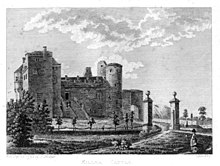Kilkea Castle
| Kilkea Castle | ||
|---|---|---|
|
Front of Kilkea Castle |
||
| Alternative name (s): | Caisleán Chill Chá | |
| Creation time : | 1180 | |
| Castle type : | Niederungsburg | |
| Conservation status: | restored | |
| Standing position : | Irish nobility | |
| Construction: | Quarry stone | |
| Place: | Kilkea | |
| Geographical location | 52 ° 56 '35.9 " N , 6 ° 53' 12.8" W | |
| Height: | 77 m ASLTemplate: height / unknown reference | |
|
|
||
Kilkea Castle ( Irish Caisleán Chill Chá ) is a castle in the village of Kilkea 5 km northwest of Castledermot in County Kildare, Ireland . It was a medieval fortress belonging to the FitzGeralds , the Earls of Kildare .
history
In 1180 Sir Walter de Riddlesford had a motte (castle) built there. One of his granddaughters married Maurice FitzGerald, 3rd Baron of Offaly; and so the rule of Kilkea came into the possession of the FitzGeralds and remained in the family for over 700 years. Sir Thomas Rokeby , the Justiciar of Ireland , used the castle as a military base and died there in 1357.
In 1414 the O'Mores and O'Dempsies ravaged the boundaries of the English-ruled area. In order to limit their violence, Thomas Crawley , Archbishop of Dublin and Lord Justice, marched from Dublin to Castledermot. The troops advanced under military leaders. He accompanied them in processions and with his prayers. The advance met his expectations because the enemy was defeated and slaughtered in Kilkea.
The castle is particularly associated with Gerald, the 11th Earl of Kildare, who was known as the "Wizard Earl" and became the male representative of the FitzGeralds when he was 12 years old after his half-brother "Silken Thomas", the 10th Earl of Kildare , executed at Tyburn in 1537. The "Wizard Earl" was sent to continental Europe for education; and on his return to Kildare his interest in alchemy aroused much interest among the neighbors of Kilkea Castle; and it was said that he had magical powers.
The earl died in 1585 and is said to return to the castle every seven years on a silver-shod white warhorse. In 1634 the castle was leased to the Jesuit order by the widow of the 14th Earl of Kildare ; and the Congregation stayed there until 1646. That year the Order hosted Archbishop Rinuccini, Apostolic Nuncio to the Confederation of Ireland , in Kilkea.
In the early 18th century, the 19th Earl of Kildare made Carton House a family home; and Kilkea Castle was leased. One of the tenants was Thomas Reynolds, a silk merchant from Dublin, a "friend" of the hero of Kildare in 1798, Lord Edward Fitzgerald , through whom Reynolds had become a United Irishman to become an informer. His role as an informant did not save the castle, which had only recently been beautifully decorated, from sacking during the rebellion. After a fire in 1849, Lord Walter, the 3rd Duke of Leinster , was a founding member of the Kildare Archaeological Society and the largest antiquarian in Kildare. He edited the journal Journals of the Association of the Preservation of the Memorial of Dead in Ireland from 1904 until his death in 1923 . After the sale of Carton House in 1949, Kilkea Castle became the seat of the 8th Duke of Leinster.
The castle and property were sold by the FitzGerald family in the early 1960s. Kilkea Castle then operated as a hotel for decades but went into sequestration in 2009 as a result of the Irish financial crisis . It was closed and put up for sale. An American businessman named Jay Cashman bought it and later reopened the hotel.
Web links
- Luxury Castle Hotel In Ireland - Kilkea Castle Official Website
- Ireland's wedding castle for keeps at € 16m
Individual evidence
- ^ Francis Grose: Antiquities of Ireland. Volume I, S. Hooper, London 1797.


